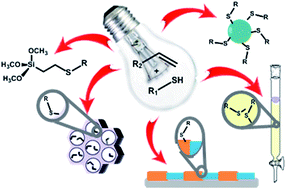Photochemical radical thiol–ene click-based methodologies for silica and transition metal oxides materials chemical modification: a mini-review
Abstract
Although known for more than 40 years in the polymer chemistry field, the photochemical radical thiol–ene addition (PRTEA) has been recently recognized as a chemical reaction with click characteristics. Photoinitiation enables spatial and temporal control of this highly efficient reaction, bridging simple organic chemistry with high-end materials synthesis and surfaces functionalization. In this minireview, we focus on the latest contributions based on the PRTEA for the synthesis of chemical precursors for silica and transition metal oxides (TMO) based materials. We summarize the mechanism of the PRTEA, the development of new families of photoinitiators and how this extremely simple approach has spilled over into the materials science arena with clear success. In particular, PRTEA adds to the collective efforts for building a reliable and straightforward chemical toolbox for surface modification and the production of sol–gel precursors, nanoparticles and thin films. The excellent perspectives for simple molecular and supramolecular building block synthesis opens up a rational synthetic route for the design and integration of these components in multipurpose platforms.


 Please wait while we load your content...
Please wait while we load your content...